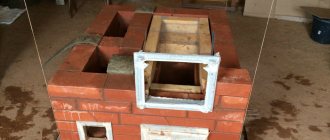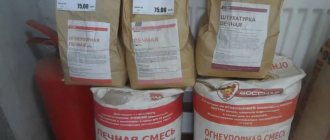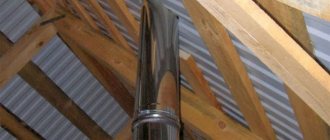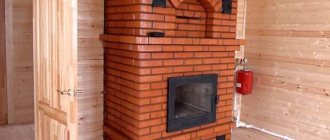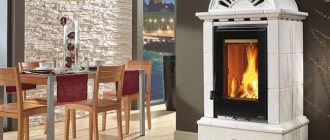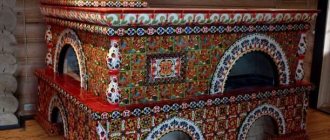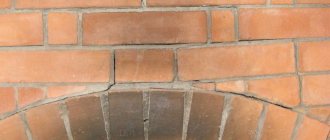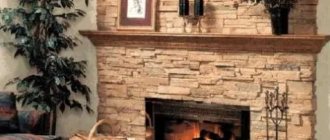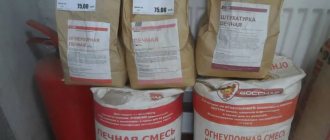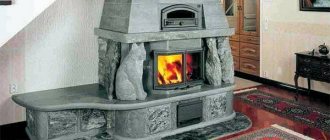High-temperature furnace sealant allows you to seal holes and cracks, which is essential for the proper and safe functioning of the heating unit. The main feature of this sealant is that it is able to adapt to different temperatures without changing its properties.
The market offers a wide selection of high-temperature sealants from various manufacturers, each of which has its own advantages and disadvantages, which are best assessed before purchasing rather than during operation of the furnace.
Areas of application of thermo-sealants and what are the dangers of ignoring cracks in stoves and fireplaces?
Fireplaces and stoves develop cracks in the facing layer during frequent and prolonged use.
This is unsightly from an aesthetic point of view, and is also dangerous to health:
- Fuel consumption increases - additional air from outside enters the combustion chamber, which speeds up the combustion process. You will have to add fuel more often, the consumption will increase 2-3 times.
- Soot and soot - through even the smallest cracks, soot gets out and settles on the ceiling, floors and furniture around the fireplace. You will have to clean several times a day.
- The entry of carbon monoxide into the living room - through cracks, smoke, which should completely exit into the chimney, leaks into the house. This is dangerous due to the development of carbon monoxide poisoning, especially in the absence of proper ventilation.
The most dangerous condition that can develop when the heating system depressurizes is the formation of combustion in the chimney. Due to the high concentration of oxygen and the decrease in combustion temperature in the combustion chamber, highly flammable soot forms on the inner walls of the chimney.
To prevent these negative consequences from overshadowing the operation of the stove or fireplace in the house, heat-resistant sealant is used for minor repairs. This is convenient, since you can cover up a gap or crack yourself at any time, postponing major repairs until the summer.
Heat-resistant sealants are also used for:
- Sealing chimney pipes during installation and repair: sealing small and large cracks along the contour and on the chimney itself.
- Waterproofing of contact points between the roof and chimneys made of various materials.
- Bonding heat-resistant gaskets with metal fittings.
- Seal cracks on the outside of a brick or metal combustion chamber.
Some sealants can be used to restore fire-resistant masonry if there is damage, but there is no way to redo the masonry.
“Craftsmen” claim that there is no point in spending money on sealants, since clay successfully copes with their function. But no kaolin compound can dry out so quickly and seal all sorts of cracks so reliably.
Expert opinion
Borodin Vasily Platonovich
Stove mason, specialist in fireplaces, stoves and heating systems
In practice, sealant is a “lifesaver” if urgent repairs are needed. You will have to tinker with the clay mortar, and the joints between the brick and the metal slab cannot be properly sealed a priori.
Why do you need chimney sealing?
The chimney is designed to remove hot combustion products from the combustion chamber of a heating unit - boiler, stove, fireplace. When any fuel is burned, it produces a lot of carbon dioxide (CO2), a small amount of carbon monoxide (CO), sulfur oxide (SO2), a small amount of oxides of some other elements, water, and unburnt fuel particles (soot). All of them are harmful to humans.
Hot water can increase the humidity in the room and lead to the formation of streaks on the walls and ceiling. Soot and soot stains can ruin the finishing of a room.
The temperature of the exhaust gases from solid fuel boilers can reach 600 °C and above, from gas boilers - 200 °C, when cleaning the smoke hog by igniting soot it reaches 1000 °C. A small stream of hot gas from a chimney is a common cause of fire. Even 200 °C for a long time is enough for the wallpaper to begin to smolder.
Therefore, the tightness of the chimney is a prerequisite for its operation. Modern heat-resistant sealants are used to seal the joints of individual elements of prefabricated chimneys. In addition, they are used for emergency sealing of leaks that occur during the heating season, when it is not possible to turn off the heating device and disassemble and replace part of the chimney.
Heat-resistant sealants are even used to seal holes and cracks in traditional brick chimneys. Traditionally, clay was used for this, but it is unreliable as a sealant. In addition, heat-resistant sealants are used to waterproof the exit of chimneys to the roof - this protects the rafters and under-roof structures from getting wet and rotting.
Types of high temperature sealants
High temperature sealants differ in the composition of their thermal paste. It is this factor that allows the production of sealants with different temperature gradients, used for finishing various parts of stoves and fireplaces.
Silicate heat-resistant sealant
The base is sodium silicate. Outwardly it looks like a black plastic mass that is convenient to work with. When hardened, it forms a dense, inelastic, heat-resistant layer.
Characteristics:
- Long-term use temperature - 1300°C.
- Short-term use temperature – 1400-1500 °C.
- Hardening time is 15 minutes, subject to the recommended ambient temperature.
- Seam thickness – 15 mm.
- Deformation without destruction of the thermal layer – 7%.
Advantages:
- It hardens quickly and is activated within the temperature range of 1-40°C.
- Does not have a pronounced toxic odor.
- The mass is plastic, easy to apply and knead.
- Long service life.
- Does not cause cracks to expand when heating an already hardened composition.
Flaws:
- It is better to use in those stoves and fireplaces that have already shrunk, otherwise there is a risk of cracking of the sealant when the stove materials expand from heating.
Great for filling cracks and gaps
Silicate sealant is recommended for use in the following cases:
- Sealing cracks and gaps that formed during the operation of fireplaces and stoves between the metal elements of the slabs and the brickwork. The adhesion in this case is better than that of any other sealant, paste or kaolin mixture.
- Sealing cracks in combustion chambers and surfaces that are in direct contact with fire and high-temperature gases.
- Sealing the joints between the roofing surface and the chimney.
- Sealing cracks and eliminating leaks from heating boilers.
Not all silicate sealants are fireproof. When sealing cracks in combustion chambers, choose sealants that indicate that use near fire is permitted.
Silicone heat-resistant seal
This category of sealants is distinguished by the addition of iron oxide to the silicone composition, which has a characteristic pink tint. Their main advantage is zero deformation, which allows the use of sealants not only in repairs, but also in the installation of heating devices.
Characteristics:
- Complete drying time is 20 minutes.
- Operating temperatures – up to +300°С.
- The ability to seal narrow but deep cracks, which is facilitated by convenient packaging in the form of a tube with a thin spout.
- Can be applied to a cold or warm base without worrying about the quality of the paste.
- Increased resistance to UV radiation, which allows the composition to be used for sealing joints on the roof.
Advantages:
- Long service life
- Waterproof
- Does not change shape when the oven temperature fluctuates, does not deform under increased loads
- Cost is lower than silicate, convenient packaging
Flaws:
- Suitable only for those surfaces whose operating temperature is within +300°C.
Main Applications
Silicone heat-resistant sealants have found themselves in the following areas of application:
- sealing chimneys on the roof;
- treatment of smoke exhaust ducts of metal and brick chimneys;
- sealing blind cracks on the surfaces of stone fireplaces and stoves.
Expert opinion
Borodin Vasily Platonovich
Stove mason, specialist in fireplaces, stoves and heating systems
Also, the high-temperature composition is used to seal joints in heating systems and circuits with elevated temperatures.
Using burlap or mesh for reinforcement
Before applying the putty mixture to the brick surface, it must be reinforced.
Method 1. In problem areas and into masonry joints, screw 75 mm long self-tapping screws, leaving the head to protrude by 10-15 mm.
Method 2. To prevent the plastered surface from becoming cracked, the walls are covered with burlap. The fabric is first soaked in a liquid clay solution, which will be used to coat the oven. The burlap is glued to the wall, smoothed to prevent the formation of air bubbles.
Alternatively, instead of burlap, you can use a metal mesh with small cells (less than 10x10 mm). To secure it, at the stage of laying the furnace, a wire with a cross-section of 3 mm is laid between the seams.
Rules for choosing heat-resistant sealant for stoves and fireplaces
In order for the purchase to be successful and the repairs to be of the highest quality, when choosing a sealant it is important to determine the following nuances:
- Operating temperature – you need to evaluate in which part of the oven the sealant will be used. If this is a chimney and external cladding, where the temperature is in the range of +300°C, then a silicone-based paste is suitable. Silicate sealants have a much higher operating temperature and are suitable for treating combustion chambers.
- Contact with open flames and gases - the sealant must be fire resistant if it is to be used inside a fireplace or stove. For exterior repairs, the usual composition is suitable.
- Degree of environmental friendliness - sealants should not contain components that, when heated, provoke the formation of toxic compounds. Otherwise, when inhaling such vapors, there is a risk of intoxication.
Naturally, pay attention to the brand and price. Unknown brands at suspiciously cheap (2-3 times lower) prices are a reason to think about possible risks.
Cladding Adhesive Components
In all types of stove and fireplace temperature-resistant adhesive solutions, the basis is the following components:
- Cement (M 400, 500).
- Fine sand.
- Mineral granules.
- Fireclay powdered fibers.
- Synthetic plasticizers and liquid glass.
Binder components - cement and sand - provide the necessary strength of the composition, mineral granules - elasticity, fireclay fibers - resistance to high temperatures, synthetic plasticizers and glass - moisture resistance, thermal expansion of materials and thermal output.
A proper ratio of the various components in the composition ensures high performance characteristics of the finished high-temperature adhesive.
The best heat-resistant sealants for stoves and fireplaces
Experts recommend buying heat-resistant sealants from those manufacturers who have earned a name for themselves with decent quality. It is better to avoid buying cheap options that do not have detailed instructions, as there is a risk of purchasing a fake.
TYTAN Professional
TYTAN Professional
Fireproof silicate sealant. Suitable for minor repairs of stoves and fireplaces, chimneys. It contains an admixture of fiberglass, which forms a dense smoke- and gas-proof layer. Has good adhesion to metal, concrete and brick.
Advantages:
- Relatively low cost.
- Operating temperature up to +1500°C.
- The composition does not contain asbestos.
- Can be stored in a tube at sub-zero temperatures.
- Can be used to seal cracks in any parts of fireplaces and stoves.
Flaws:
- Complete drying takes at least 24 hours.
The average cost for a tube weighing 300 g is 250 rubles. After use, the sealant is closed using a threaded cap. It can be stored for quite a long time, maintaining its qualities.
Ognez 1600
Ognez 1600
The sealant allows you to effectively seal cracks and glue surfaces together. A distinctive feature is the need to wet the treated surface with water, which improves adhesion.
Advantages:
- Bonds concrete, glass, brick, stone, ceramics.
- Waterproof, suitable for external chimney sealing work.
- The highest operating temperatures, which allows it to be used in all parts of the heating device.
- Easy to apply with a spatula, convenient to work with.
- Can be painted using varnishes and paints with natural composition.
- High level of environmental friendliness.
Flaws:
- Not identified.
The cost of a domestic product is about 240 rubles. When stored correctly, it is not afraid of freezing and defrosting cycles.
MASTERTEKS PM
MASTERTEKS PM
Polish silicate sealant, black. It is easily applied to the surface without requiring preliminary preparation. Suitable for filling various cracks and sealing joints. Dries relatively quickly.
Advantages:
- A convenient screw cap on the spout prevents air from getting inside the tube during storage.
- Dries quickly if the recommended layer thickness is observed.
- Does not crack when the surface cools.
- Excellent adhesion
Flaws:
- Not identified.
The sealant is good in every sense and is literally ideal when working with a chimney.
Application rules
To ensure that the tightness of the connection does not cause any complaints, it is important to follow some rules when applying sealant:
- The area where the sealant is applied is cleaned of dust and degreased. For silicone products, the application site should be thoroughly dried. For fireproof ones, moisten with water.
- You should work with gloves, avoiding contact of the product with your skin. If this happens, you should rinse the skin with plenty of water.
- For complete hardening of the insulators, you should wait 24 hours with the first firebox.
- It is necessary to conduct a test fire to check the sealing and final fastening of the sealing materials.
- You should start working with any composition only after carefully studying the manufacturer’s recommendations.
The principle of working with high-temperature sealants
In order for the repair or installation to take place at the highest level, the master should divide the work into several stages, and then complete each one taking into account some of the nuances. The more correctly this is done, the longer the thermal composition will last.
Silicone compounds
Germent - moment
This sealant helps to connect two surfaces made of different materials, as well as seal fairly large cracks.
We will divide the work into several stages:
- Surface preparation : sand the metal surface, remove dust; if water was used for cleaning, wait until it evaporates completely.
- Preparing the sealant : the container is carefully opened and placed in a special construction gun, which makes application of the product more comfortable.
- Applying sealant to the surface : the thickness of the extruded layer should be slightly less than the crack itself. During polymerization, the sealant will fill all microcracks and increase slightly in size.
- Cleaning up stains : Before the mixture has set, excess should be removed with a spatula.
The drying time directly depends on the temperature and humidity in the room. The warmer and drier it is, the faster the sealant will polymerize. Accordingly, in a cool and damp room, the 20 minutes recommended by the manufacturer in practice can stretch to 40-50 minutes.
Silicone pastes
The main difference is the need to work quickly and accurately, since silicone thermal pastes harden very quickly, and there will be no way to correct anything in the future.
We work according to this scheme:
- Surface preparation : sand all surfaces to be treated. If there are seams, then their outer part should be taped with masking tape so as not to stain the surface.
- Preparation of sealant : the tube is inserted into the gun, the tip is cut off diagonally.
- Application : apply a thin layer quickly enough, remove excess immediately.
Expert opinion
Borodin Vasily Platonovich
Stove mason, specialist in fireplaces, stoves and heating systems
I do not recommend making a layer of paste larger than stated in the instructions. This will cause a relatively long drying time, and also does not guarantee a high degree of adhesion of surfaces.
How to prepare the composition yourself
You can prepare putty for the stove yourself. To do this you will need fine sifted sand and medium fat clay.
The dried clay is mixed with sand and lightly salted water is added. After three days of soaking, the clay-sand solution is thoroughly mixed again and they begin to putty the seams or plaster the entire surface of the oven.
There are several nuances to preparing a homemade heat-resistant putty solution.
If you have skinny clay, then instead of salted water, mix the composition with skim milk (without cream). To make the putty white, you can add a little slaked lime to it. The plastered surface can also be whitened with a mixture of crushed chalk and low-fat milk. The durability of this coating is about 10 years.
Tips and tricks
Experienced experts recommend the following:
- Never use sealant for purposes other than its intended purpose. If it is not intended for repairing combustion chambers, then there is no point in using it there. Saving a penny - a large-scale loss, plus harm to health and danger to life.
- Carry out repairs after stopping the combustion process, taking into account the operating temperature of the sealant, as indicated on the packaging.
- Remember that sealants must dry thoroughly. Give them the time recommended by the manufacturer.
- To improve adhesion between surfaces, they should first be sanded well. A rough surface will improve the adhesion of metal and brick.
- Remove excess thermo-compositions before they harden, otherwise it will be extremely problematic to do this later.
- Do not buy products from dubious brands that do not contain instructions for use.
- Always follow the precautions stated by the manufacturer.
Remember that repairing cracks and insulating individual sections of stoves and fireplaces is a responsible job. If you don’t have the skill, then it’s better to entrust it to professionals.
Frequently asked questions and answers
It is not always possible to find complete information in the instructions on how to properly use the sealant. This leads to a number of errors and problems in the future, which in no way depends on the quality of the thermal paste itself.
Is it possible to seal the joint between the chimney and the roof when it is frosty outside?
It is better to carry out all work with sealant in the dry and warm season, then its adhesion will be as strong as possible. Look for sealants that work in cold temperatures, but be aware that they will take a long time to dry. If it is -2°C, then most likely the process will be successful. If we are talking about severe frosts, then it is better to wait for a thaw, since the mixture will not be able to polymerize correctly.
Experts use a trick, forcing the sealant to work using heat guns. The latter are located in close proximity to the processing site, increasing the temperature by 10-15°C.
The sealant is not drying well, what can I do to help?
This picture occurs if the ambient temperature approaches zero. Accordingly, to solve the problem, the surface and air should be slightly warmed up. But the best adhesion of the two surfaces occurs when all the work is completed in the summer.
Can the sealant cause a spark?
If we talk about those sealants that are used for combustion chambers, then they do not contain any elements that can somehow influence the combustion process. But such a sealant must be marked “fire resistant”. This means that it can be used in areas of active combustion.
In conclusion, it is worth noting that heat-resistant sealants have different compositions and can be used for different purposes. Before purchasing, it is important to evaluate at what temperatures it will be used in order to determine the desired composition. Please ensure that the sealant does not contain hazardous components that can release toxic substances when heated.
Types of thermosealants by release form
Most manufacturers sell insulating compounds for furnaces in tubes. Before use, the cylindrical container is placed in a construction gun.
This option is most convenient when filling masonry joints and formed cracks. Sealants are easily squeezed out of the packaging due to their homogeneity and semi-liquid consistency
There are products in soft small tubes. It is advisable to use them for processing small areas. No additional equipment is needed to apply the composition.
High-temperature sealants are produced in the form of one- or two-component compositions. The first category is most actively used in everyday life.
The one-component composition is ready for use and does not require any preparation. This sealant takes longer to dry, leaving time to correct possible errors.
Two-component compositions are supplied in a set - hardener and paste. Substances are mixed before use in strictly designated proportions
This option is more often used in industrial settings, when it is necessary to process large areas. Two-component mixtures have not taken root in everyday life due to the technological complexity of use.
